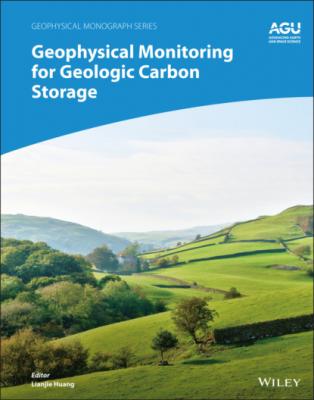ТОП просматриваемых книг сайта:
Geophysical Monitoring for Geologic Carbon Storage. Группа авторов
Читать онлайн.Название Geophysical Monitoring for Geologic Carbon Storage
Год выпуска 0
isbn 9781119156840
Автор произведения Группа авторов
Жанр География
Издательство John Wiley & Sons Limited
The controlled source electromagnetic (CSEM) method is mostly an offshore monitoring technique using electromagnetic remote‐sensing technology to map the electric resistivity distribution of the subsurface. In Chapter 17, Tveit and Mannseth introduce a Bayesian sequential inversion methodology for combining geophysical data types of different resolutions. They first use CSEM or gravimetric data to invert for a low‐resolution result, which is used as prior information for inversion of seismic amplitude‐versus‐offset (AVO) data to improve resolution. The unknown geophysical parameters, for example, electric conductivity, density, and seismic velocity, are represented using a carefully designed parameterization based on the level‐set framework, which allows for representation of region boundaries defined by the large‐scale CO2 plume and slowly varying geophysical properties inside and outside the CO2 plume. They show that seismic AVO inversion results are improved with the sequential inversion methodology using prior information from either CSEM or gravimetric inversion.
Fluid flow through a porous media can generate electrical potential gradient or streaming potential along the flow path. The self‐potential (SP) technique is a passive electrical monitoring method that measures spontaneous or natural electrical potential from the subsurface. In Chapter 18, Nishi and Ishido introduce the SP monitoring technique. Two SP mechanisms are studied with numerical simulations. The electrokinetic coupling mechanism produces SP caused by changing reservoir conditions such as pressure disturbance from results of reservoir simulation. The geobattery mechanism creates a galvanic cell caused by subsurface electrochemical conditions near a metallic well casing. CO2 injection alters deeper reducing environment and redox potential, which results in an SP anomaly. If a substantial amount of CO2 migrates upward into a shallow fresh water aquifer through a vertical fault and creates substantial pressure disturbances, observable self‐potential measurements caused by electrokinetic coupling would provide a cost‐effective monitoring method for CO2 leakage detection. They observed a local self‐potential increase near the wellhead of an injection well associated with CO2 injection at the Aneth oil field in southeastern Utah, USA.
1.5. CASE STUDIES OF GEOPHYSICAL MONITORING
In Chapter 19, Bauer et al. present a case study of microseismic monitoring at the Illinois Basin Decatur Project of the Midwest Geological Sequestration Consortium. The project site is located in east‐central Illinois in the north‐central area of the Illinois Basin in the midcontinent region of the United States. For over three years, the project safely injected nearly 1.1 million tons of supercritical carbon dioxide into the base of a 500‐m thick saline sandstone reservoir at a depth of 2.14 km. They collected a unique data set encompassing an extensive quantity of microseismic and concurrent operational monitoring data before, during, and after injection operations, and presented results of microseismic event location and focal mechanisms. They demonstrate the compatibility of technical and operational activities under evolving and challenging conditions.
In Chapter 20, Balch and McPherson present an overview of the Phase III of the Southwest Partnership on Carbon Sequestration (SWP) in Farnsworth, Texas, USA. The project has completed its injection period with the storage of over 700,000 tonnes of CO2 at an active commercial‐scale CO2‐EOR field. They summarize the interrelationship of monitoring activities, the status of postinjection monitoring, and the optimization required to maximize storage while providing the greatest oil production incentive to the field operator, among others.
In Chapter 21, Hovorka gives an experimental study of testing and assessing geophysical monitoring methods for tracking CO2 migration during large volume injection at the Southeast Regional Sequestration Partnership project in Cranfield, Mississippi, USA. The project uses several geophysical tools to detect CO2 in the injection zone, including time‐lapse 3D seismic, 3D VSP, time‐lapse cross‐well seismic, electrical resistance tomography, borehole gravity, time‐lapse wireline sonic, pulsed neutron logging, and fluid density logging. The experiment reveals the strengths and weaknesses of different monitoring methods. Interference among different monitoring tools is significant. The site operator should avoid deploying as many tools as possible, but rather select best tools for the job and deployment condition. Monitoring data play an important role in calibrating the reservoir model.
In Chapter 22, Romdhane et al. describe a case study on quantitative monitoring at Sleipner in Norway. They evaluate a methodology combining high‐resolution seismic‐waveform tomography and rock physics inversion for monitoring the CO2 plume at Sleipner. They show that using multiparameter seismic inversion or multiphysics integration of data can lead to a better discrimination between the different effects of CO2 injection/migration on rock physics properties and reduce inversion uncertainties.
Finally, in Chapter 23, Bergmann et al. present an overview of geophysical monitoring of CO2 injection at Ketzin in Germany. They describe seismic measurements and electrical resistivity tomography performed during the period of site development and CO2 injection. They find that a combination of several geophysical methods is preferred.
ACKNOWLEDGMENTS
This work was supported by the U.S. Department of Energy (DOE) through the Los Alamos National Laboratory (LANL) operated by Triad National Security, LLC, for the National Nuclear Security Administration (NNSA) of U.S. DOE under Contract No. 89233218CNA000001, and through Lawrence Livermore National Laboratory (LLNL) under Contract DE‐AC52‐07NA27344. We thank the AGU Publications Director Dr. Jenny Lunn and Dr. Estella Atekwana of the AGU Books Editorial Board for their careful review and valuable comments. We also thank David Li of LANL for his review. This chapter is approved for public release by LANL (LA‐UR‐21‐27246) and by LLNL (LLNL‐BOOK‐824879).
2 Geodetic Monitoring of the Geological Storage ofGreenhouse Gas Emissions
Donald Vasco1, Alessandro Ferretti2, Alessio Rucci2, Giacomo Falorni3, Sergey Samsonov4, Don White5, and Magdalena Czarnogorska4
1Energy Geosciences Division, Lawrence Berkeley National Laboratory, Berkeley, California, USA
2 TRE ALTAMIRA Srl, Milan, Italy
3 TRE Altamira Inc., Vancouver, British Columbia, Canada
4 Canada Centre for Mapping and Earth Observation, Natural Resources Canada, Ottawa, Ontario, Canada
5 Geological Survey of Canada, Natural Resources Canada, Ottawa, Ontario, Canada
ABSTRACT
Geodetic

